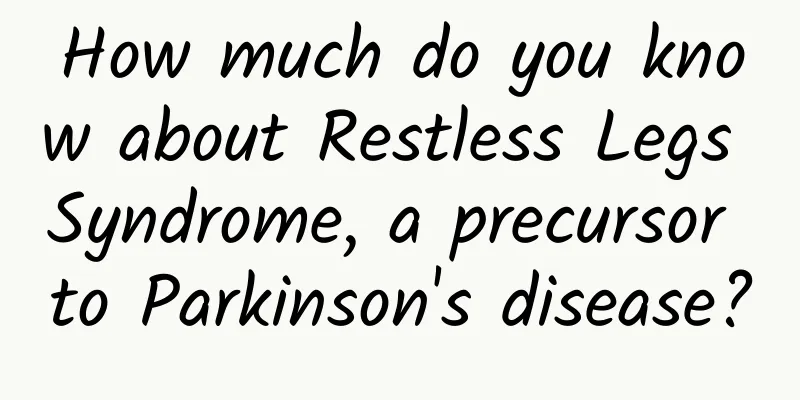How much do you know about Restless Legs Syndrome, a precursor to Parkinson's disease?

|
Parkinson's disease (PD) is the second most common degenerative disease of the central nervous system, mainly characterized by bradykinesia, rigidity and tremor, accompanied by other motor and non-motor symptoms. The annual incidence rate is 10-20/100,000 cases, and it is most common in the elderly. It is estimated that by 2030, Chinese PD patients will account for half of the world's total.
Key Features 1. Restlessness : Often walking around or rubbing legs when resting, and often tossing and turning or shaking the body when lying in bed. 2. Paresthesia: There is a crawling discomfort deep in the thighs when resting, especially in the early morning and at night. It often affects both sides, forcing the patient to move his legs frequently. 3. Periodic leg movements during sleep are stereotyped flexion movements that occur at least 40 times in 6 hours of sleep. 4. Involuntary leg movements when awake Involuntary flexion movements of the lower limbs often occur when resting in a lying or sitting position. 5. Sleep disorders: Due to abnormal sensation and leg restlessness, patients often suffer from insomnia. 6. Worsening at night Although there may be abnormalities, leg movements and restlessness during daytime rest, there is a clear tendency for the symptoms to get worse at night. Causes Patients often describe it as "there's just no comfortable place for my legs to rest." This is where the name of the disease comes from. Parkinson's disease is one of the causes of secondary restless legs syndrome. The cause of restless legs syndrome is that patients often have a family history and are hereditary. On the other hand, the disease is caused by iron deficiency anemia, pregnant women or parturients, late-stage kidney disease, rheumatic diseases, diabetes, and vitamin (B12) deficiency. Nursing 0 1 Psychological guidance <br /> Since the disease is confirmed to be an autosomal dominant genetic disease, patients are very worried about whether their descendants will be sick. Patients have unbearable crawling and itching sensations, and have compulsive movements and restlessness, which affect sleep, so they often have negative emotions such as fear and anxiety, which aggravates the condition. Nursing staff should patiently tell patients about the common sense of the disease, recommend their descendants to go to the hospital for a physical examination to relieve their mental concerns, and ask them to keep their emotions stable to avoid tension causing the disease to occur.
0 3 Drug guidance <br /> Levodopa is the first choice for drug treatment, starting with a small dose. A combination of levodopa and a dopa decarboxylase inhibitor, such as Madopar, can also be used. For severe patients, dopamine receptor agonists can be the first choice. For those who have contraindications to dopamine drugs, clonazepam can be considered, which is also effective. Anticonvulsant drugs such as carbamazepine, sodium valproate, and gabapentin can be used as second-line drugs; some refractory patients can be treated with tramadol and opioids. Other methods include: physical therapy, acupuncture, massage, etc. 0 4 Rehabilitation guidance <br /> The disease often worsens during rest, evening or late at night, and is relieved after activity. Bed rest is the most common aggravating factor, and walking is the most effective way to relieve leg symptoms. Patients can be assisted in kicking or pedaling, walking back and forth in the corridor of the ward for more than 1 hour every day, performing limb massage for 0.5 to 1 hour every day, and taking a hot water bath once a day in the medicinal bath center. Hot water baths before going to bed are more effective in relieving nighttime discomfort symptoms. 0 5 Safety Guidance <br /> Patients often suffer from insomnia, which leads to poor spirits and lack of concentration. Patients are elderly and often have to walk back and forth, pedal, and stretch their limbs to promote recovery. Taking benzodiazepines can often cause the elderly to fall at night. Therefore, safety issues cannot be ignored. Nursing staff should often guide patients and their families to keep the floor clean and dry, not mop the floor too wet, and the activity area should be wide and free of obstacles. When going out, someone should accompany the patient, walk slowly, add a guardrail beside the bed at night, take the medicine according to the prescribed dosage and time, etc., to ensure the safety of the patient.
References [1] Tysnes OB, Storstein A. Epidemiology of Parkinson's disease[J]. J Neural Transm (Vienna), 2017,124(8):901-905. [2] Li G, Ma J, Cui S, et al. Parkinson's disease in China: a forty-year growing track of bedside work[J]. TranslNeurodegener, 2019,8:22. [3] Gossard TR, Trotti LM, Videnovic A, et al. Restless Legs Syndrome: Contemporary Diagnosis and Treatment[J]. Neurotherapeutics, 2021,18(1):140-155. [4] Szatmari SJr,Bereczki D,Fornadi K,et al. Association of Restless Legs Syndrome With Incident Parkinson's Disease[J].Sleep,2017,40(2):zsw065[5] Lv Q, Wang X, Asakawa T, et al. Pharmacologic Treatment of Restless Legs Syndrome[J].Curr Neuropharmacol,2021,19(3):372- 382. [5] Fan Ronglan, Tang Zhihui. Self-care guidance for elderly patients with restless legs syndrome[J]. Nursing Research. 2003, 17(94): 453. [6] Yu Zhennan, Fu Ying, Ma Qinying, et al. Advances in the treatment of restless legs syndrome[J]. Journal of Hebei Medical University. 2022, 43(7): 859-865. Author: Wu Yunfeng Gao Caiping Unit: Shanghai Tongji University Affiliated Yangzhi Rehabilitation Hospital Chief Judge: Zhai Hua (Shanghai Yangzhi Rehabilitation Hospital Affiliated to Tongji University, Vice Chairman of the Science Popularization Working Committee of the Chinese Rehabilitation Medicine Association) Editor: Zhu Xiaoqing (Xinhua Hospital Affiliated to Shanghai Jiaotong University School of Medicine) |
<<: Three ways to quench thirst after surgery
Recommend
What causes sudden breast pain?
Breast diseases are very common among women today...
What should a 30-year-old woman eat to maintain her health?
At the age of thirty, most female friends have al...
Is cervical adhesion easy to treat?
If cervical adhesion is not treated with the corr...
What are the reasons for not having menstruation for two months?
During puberty, girls always have irregular menst...
How long does it take for the wound to stop hurting after a natural birth stitch?
During the process of natural childbirth, women m...
My lower abdomen and waist hurt like menstruation
Abdominal and waist pain similar to menstrual pai...
Sensor Tower: Global popular shopping app list in the first half of 2021
The global outbreak of the epidemic in early 2020...
Can a virgin get vaginitis? The truth is this
If a woman's vagina is infected, it may cause...
Singapore bans milk tea advertising. Can drinking milk tea cause diabetes?
Before answering this question, let's take a ...
Be careful! These daily habits increase the risk of joint diseases. Are you affected?
Have you ever experienced joint pain? Arthritis, ...
Why does my chest hurt?
Chest pain is breast pain in women. This phenomen...
How long is a woman's cervix?
The uterus is an important female reproductive or...
Attention, fans of "noodle slurping"! This type of food poisoning is more common in summer and can be fatal!
Fried rice noodles, Guilin rice noodles, Changde ...
Why does a pregnant woman’s buttocks itch?
Pregnant women may encounter many physical discom...
The significance of progesterone test during the luteal phase
Progesterone levels are essential for women durin...









